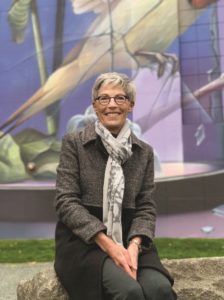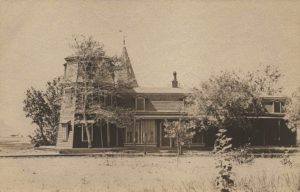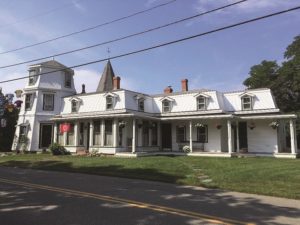Lynn Smiledge began her career producing medical films in the pre-computer era of the late 1970s, creating educational animations and advertising for pharmaceutical companies. Back then, “It was all pen and ink, pencil crayon, and carbon dust,” she says.

It took her from Philadelphia to Columbus, Ohio to Kansas City, and, finally, to Andover. In each place, she and her husband lived in old houses “and we fell in love with them,” she says. What began as a hobby — Smiledge gave walking tours of the historic German Village and Brewery District in Columbus — one day beckoned as an alternative career. In the early 2000s, on a morning commute from Andover to Cambridge, Smiledge saw a billboard advertising a certificate program in historic preservation at Boston Architectural College. She dropped everything and enrolled.
“History is who we are,” says Smiledge. “The historical built environment expresses our character. It is where we came from.” She believes studying ignored or forgotten stories helps a society understand the present. And there is always, she adds, “the aesthetic piece.”
This year, Smiledge was hired by the Wellfleet Historical Commission to perform a survey of historic buildings in town. She entered the role with more than 15 years of professional preservation experience, including her work as chair of the Boston Landmarks Commission.
On Oct. 25, she presented an overview of her work titled “Historic Houses and the Stories They Tell.” With support from the Wellfleet Public Library and Wellfleet Historical Society, her talk drew an audience of 185 over Zoom.
Smiledge offered a survey of architectural styles dating from 1690 to the mid 20th century. She detailed the physical features of Wellfleet’s Cape Cod houses (half, three-quarter, and full), and explained the Federal, Greek, Gothic, Colonial Revival, Italianate, Second Empire, and Mid-century Modern styles using photos of houses in town.
Smiledge also discussed the methodology of the Wellfleet Historic Survey Project, which is an update of one done in the 1980s. The 2021 survey emphasizes documenting houses that have traditionally been overlooked — ones associated with the working class, African Americans, and indigenous peoples.

Most interesting to the audience were the “house stories” — vignettes more about the occupants than the buildings themselves. Smiledge interwove anecdotes about peculiar experiences of past Wellfleet residents with social, economic, and aesthetic details of their abodes.
For example, the grand house at 145 Holbrook Ave. overlooking the harbor once was the home of France B. Hiller (1845-1900), the widow of Dr. Henry Hiller, who died in 1888. Their main residence was in Wilmington. The couple designed their own luxury caskets, which supposedly took five craftspeople seven years to build.
France Hiller was an eccentric lady. When she was 48, five years after the death of Henry, who was her second husband, she married Peter Surette, “her devoted coachman.” He was half her age and agreed to change his name to Henry Hiller, the same as her late husband. Henry the second outlived her by nearly 40 years.
The Holbrook Avenue house, known locally as Morning Glory, comprises “a 19th-century windmill that was moved to the site, enlarged with a series of additions, and converted to a residence,” according to the architectural description.

To unearth the stories behind each property, Smiledge looks for census records, deeds, old newspapers, and documents from local historical societies. But the Outer Cape presents some unique challenges. Because of a fire at the Barnstable County Registry of Deeds in 1827, most deeds predating that year were lost. Furthermore, many Wellfleet — as well as Provincetown — houses were moved from other sites without documentation, making establishing their actual age difficult. With recycled materials from old houses being used in newer houses, this difficulty increases exponentially. Fortunately, many houses built after the middle of the 19th century still have fascinating social histories.
For those wanting to do their own architectural research, Smiledge recommends the Mass. Cultural Resource Information System (MACRIS). A search by address will connect to “Form B,” which contains a photo of the house, a map, an architectural description, and historical details.
